This post may contain affiliate links from products and services we love and trust.
100mm/105mm or 60mm?
Adding a macro lens for food photography to our kit is really exciting, (I know, I know. I’m a total dork).
But seriously, it’s kinda a sign that we are progressing in our food photography journey and are ready to explore new ways of composing our images!
One of the most common questions that I get from creatives is regarding lenses, lens upgrades and which lens should you add to your kit.
Most of the time we are upgrading or adding to our kit, we’re doing this from wider focal lengths like the 18mm-55mm (which has a different minimum focusing distance and maximum aperture to a macro).
A macro lens for food photography will allow you to explore composition and go beyond overhead shots, which are a little easier to compose (and do well) than 45-degrees.
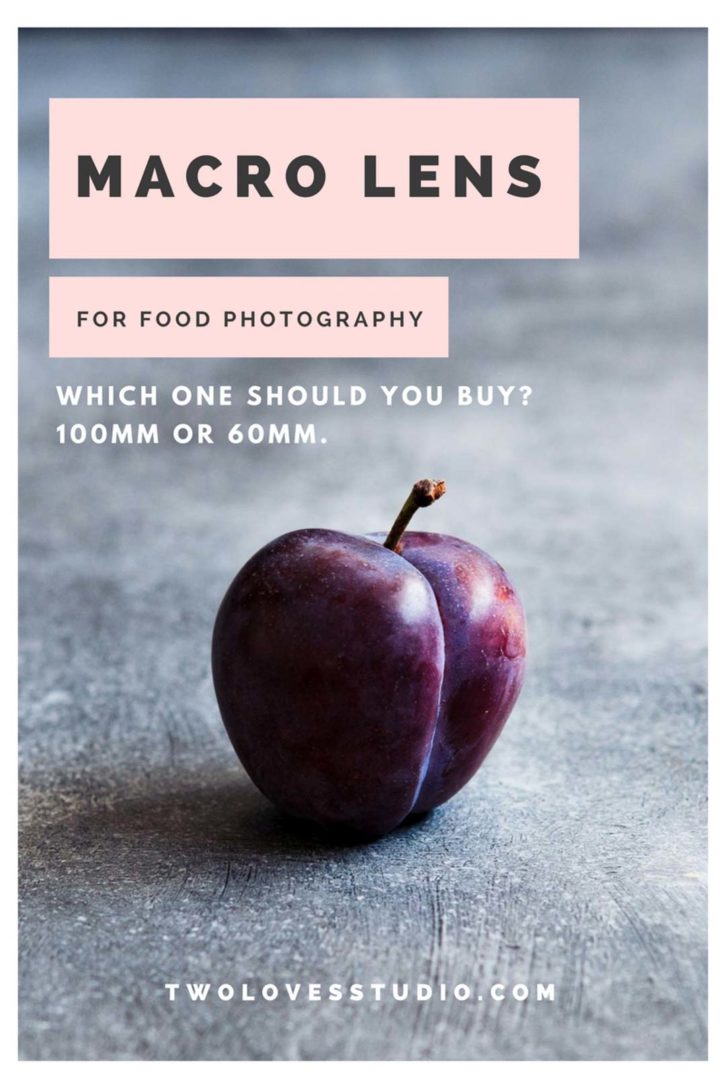
So which macro lens will it be?
In one of my most popular posts about lenses, 4 Ultimate Food Photography Lenses for Beautiful Photos, I talk about (of course) the four most common and beautiful lenses that food photographers will want to think about adding to their kit.
I also chat about how I use each lens I recommend.
And the BIG question is always, which lens should I get for a cropped sensor vs a full frame…
For those of you who know me, you’ll know that I like to empower others to make their own choices. Knowledge is power, right?
So normally I lay down the education and let you decide. So after you’ve filled your cup with knowledge from my most popular lens post, I’m going to throw it out there that this is what I’d recommend based on whether you currently shoot with a cropped sensor or a full frame.
But what makes me so sure? Well, this is what I did when I was starting my journey and it worked for me.
Therefore I’d do it again 🙂 As I shoot Nikon, these are the two lenses I have (love) and use. Canon equivalents are interchangeable for this post.
Let’s dive in.
FULL FRAME – 100mm/105mm
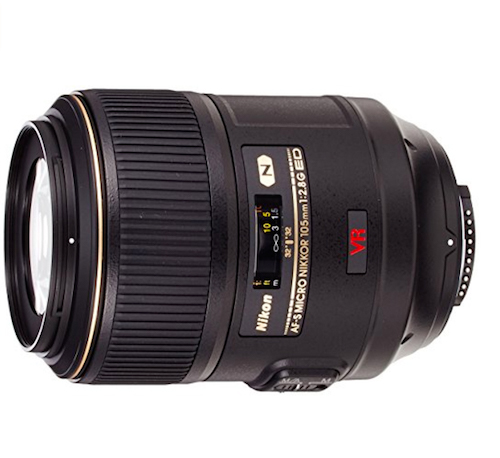
CROPPED SENSOR – 60mm
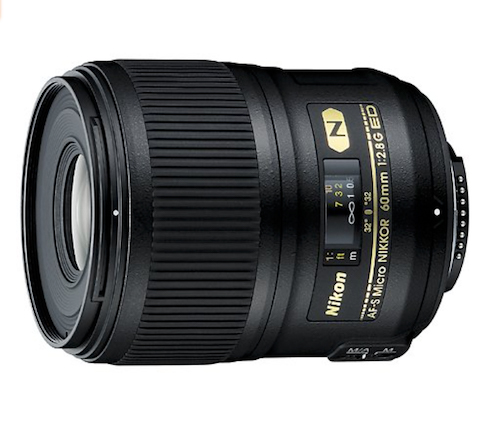
The evidence. Full frame v cropped sensor.
When we are trying to improve our work, we tend to think that one major thing will improve our images – aka a new lens. But that isn’t always the case.
I know when you have saved your business pennies to purchase a new macro lens for food photography, we can still feel hesitant about which macro lens is better?
Rather than thinking which lens will work for the camera and sensor we have.
I come from a camp that views things as YOU are the one that makes the great photo, not (solely) your gear. Therefore, here are two images that I took.
One with my Nikon D800 and my Nikkor 105mm 2.8 AND the other my Nikon D300 and my 60mm 2.8.
What do you think?
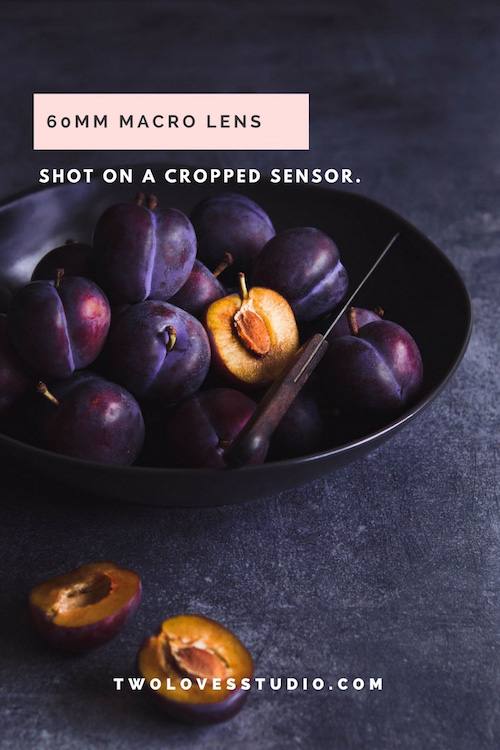
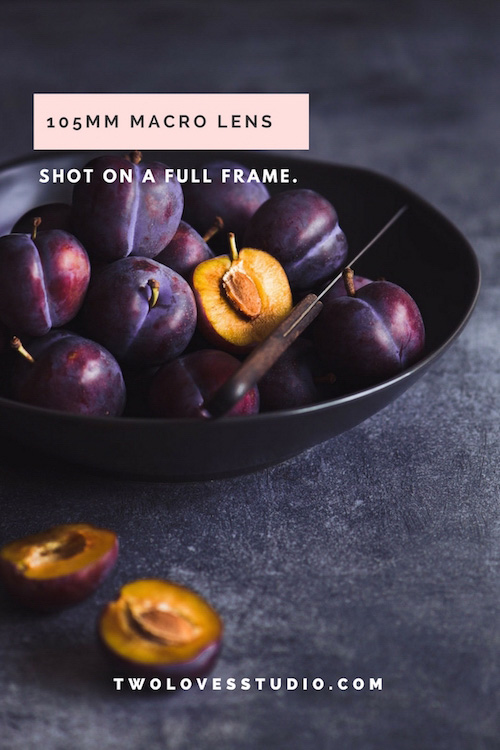
NOTE: They were taken from on a tripod which was not moved throughout the shoot. Edited the same, with the same settings. You can see the slight difference in the amount of light between each lens.
The 100mm/105mm macro lens for food photography.
If you’re shooting with a full frame, this lens is calling for you!
This lens was one of the ultimate lenses that I looked forward to adding to my kit just before I started to freelance.
She’s a bit pricey, but kind of an essential focal length to capture those beautiful 45-degree shots that we all love.
It allows us to get those really flattering and tight 45 degree shots of our dish, whilst keeping a shallow depth of field for the background elements. It’ll cut through the distortion at this angle that you get when you shoot with a wider focal length like a 50mm.
You’ll have a better minimum focusing distance and some great maximum aperture options.
Why do I recommend the 100mm/105mm macro over the 60mm macro for full frame users?
When shooting with a full frame, the focal length you use is the focal length you see. There is no crop factor to deal with. So a 100mm macro lens on a full frame is a 100mm.
Likewise, a 105mm macro lens on a full frame is a 105mm.
And you guessed it, a 60mm macro lens on a full frame is a 60mm.
Shooting with a 60mm macro lens on a full frame camera won’t allow you to capture those gorgeous 45-degree shots and get those really flattering shallow backgrounds that a 100mm/105mm will produce.
Nor should food photography be macro photography either. We need to see a bit more of the scene and story to really connect. So the 60mm on a full frame is going to act more like a 50mm, and you’ve most likely already got a 50mm.
You’ll most likely use it for overhead and wider shots.
Related: 4 Ultimate Food Photography Lenses For Beautifull Photos
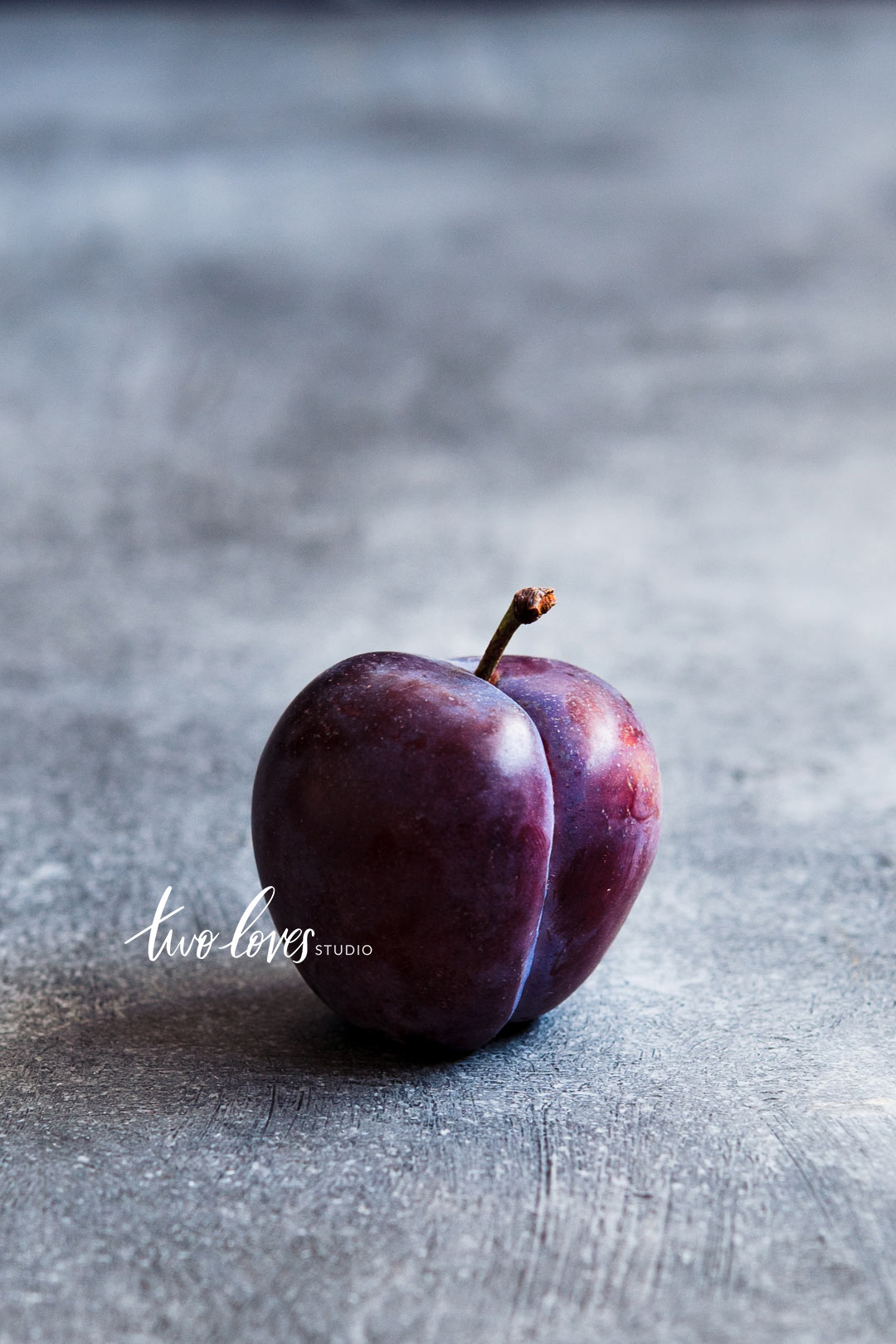
The 60mm macro lens for food photography.
If you are shooting with a cropped sensor, then this guy is ready for your kit!
This was the first lens that I purchased, so I totally have a soft spot for it (and still use to today). It captures the light so beautifully and is ever reliable.
As far as food photography lenses go, this is one is for the smart photographer. On a cropped sensor you can use it like a 90mm (close enough to the 100mm), and if you ever upgrade you can still use it like you would a 50mm.
It also helps when space is an issue for you as you can get closer to your subject.
When shooting in combination with a cropped sensor, this lens will act more like a 100mm and allow you to get those really flattering and tight 45 degree shots of our dish with that shallow background we all drool over.
It’ll cut through the distortion at this angle that you get when you shoot with a wider focal length like a true 50mm.
Why do I recommend the 60mm macro over the100mm/105mm macro for cropped sensors?
There are a couple of reasons here.
Cropped sensor cameras are generally less expensive than full frames and we are starting out, it’s smart to get started and invest in what we can afford.
(There is no point in having the best gear when we start out as we really don’t know how to get the most out of it. You can always sell your old gear and upgrade later).
So investing in less expensive lenses isn’t unwise, investing in expensive lenses that you don’t need is.
On a cropped sensor the 60mm macro lens is more like a 90mm (where you have a crop factor of 1.5) and this is pretty darn close to the 100mm macro lens and will (yes, I know I sound like a broken record) allow you to capture those beautiful 45-degree shots.
If you go for the 100mm/105mm macro lens on a cropped sensor you will be shooting at a focal length of 150mm (where you have a crop factor of 1.5) and this is going to be a super tight crop.
If space is an issue, or if your style focuses on a lot of styling and story – this will be super frustrating on a cropped sensor.
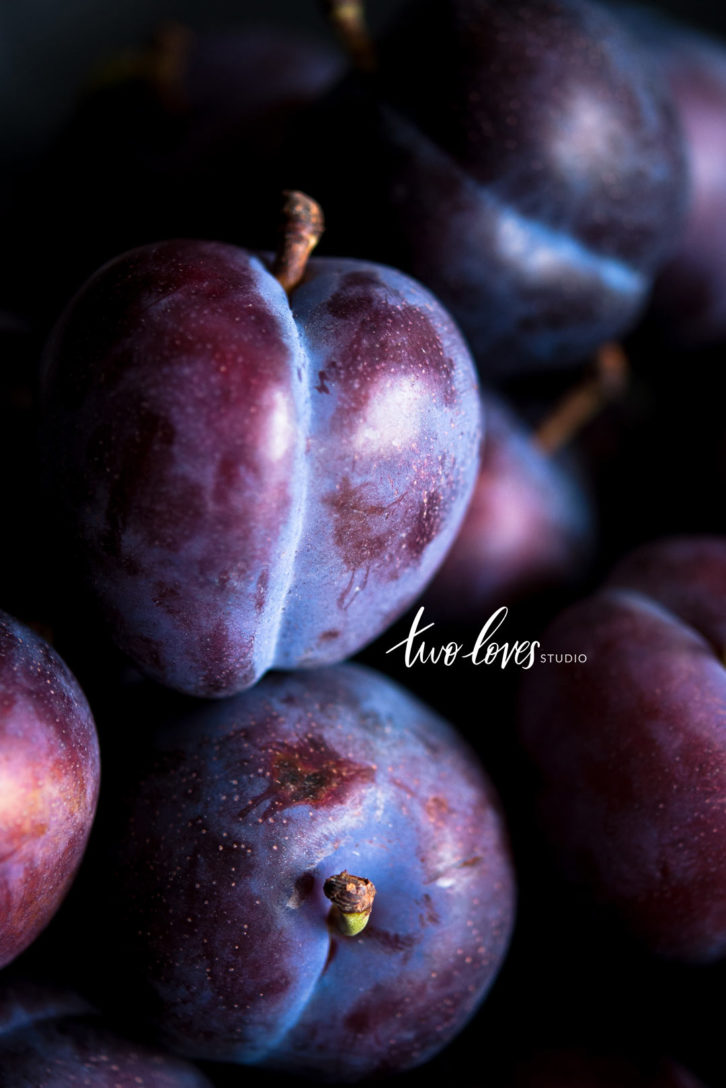
Getting the 100mm/105mm macro lens for food photography on a cropped sensor.
There is always exceptions to the rules right?
So when would I recommend investing in the 100mm/105mm macro lens when you have a cropped sensor. This would be an unequivocal yes if you are planning on upgrading to a full frame in the near future and have the budget for it.
I still use my 60mm macro lens for food photography on a full frame, but I have the luxury of having both lenses to play with.
Resale values of lenses are always lower, so if you know that you will be upgrading, have the space to shoot on a cropped sensor until you do – then this would be my pick.
Did this post give you some clarity about which macro lens for food photography you might get next? Let me know which macro lens you’re going to go for!
Two Loves Studio was not paid to write this post, however, it does contain affiliate links. If you purchase an item from an affiliate link, Two Loves Studio does get a commission on the sale which goes towards continuing to provide awesome content. Only affiliates for products/services I believe in and that align with my values appear on this site.
Two Loves Studio was not paid to write this post, however, it may contain affiliate links. If you purchase an item from an affiliate link, we do get a commission on the sale which helps us run this site. Only affiliates for products/services we believe in appear on this site.



Shibani
Rachel, i cannot believe that this post came to me in the right time. You have done a great job in explaining the whole post in such a beautiful way. I have been debating this in my mind since last week So this is confirmed that i am buying the macro lens .. it is worth.
Rachel
Hey Shibani! How about that hey. Super glad to hear that was useful for you in making a decision. Do you know which one you are thinking of getting? I’d love to know.
Rayzel
Hey there!
I have your course and I’ve already learned stuff in just the first few lessons.
Q! I only have a crop frame right now. I notice in these two images that the full frame camera REALLY looks better – as in the depth and shape of the photo- hard to explain- the crop sensor looks a lot more “flat” for lack of a better word- is this because of the full frame? If so, these two images may have convinced me to upgrade to a full frame. Can you weigh in on that? I had thought that crop frame meant that the only thing that was different was that I’d have to step further away, but in these two images the quality really seems different when it comes to the shape and feel and depth to the full frame vs. the crop – is this accurate or do you think something else is making the crop frame version look flatter?
Thank you for any input!
Rayzel
Rachel
Hey, Razel! Thanks for sharing your thoughts, I would love to chat about this with you 🙂
Photography isn’t just as simple as that. There are always many factors that come into play to get a desired outcome.
There are many differences between a full frame and a cropped sensor, the most important one being the quality of the sensor. There are a number of things that a full frame sensor has that allows for it to take better quality images. Having said that, the lens that you use also plays a role in getting quality, sharp images.
I don’t doubt that you prefer the full frame image taken with a 105mm, and it can come down to personal preference.
A couple of things to think about is that these are web res quality images exported at 85% quality. Then had graphics put onto them and exported again. There will be quality lost from both images here for sure. Comparing the two full size on my computer, the full frame will generally have more quality but from what I saw it was marginal for small print and web use.
The next thing to think about is that on the full frame, the 105mm is a 105mm. The 60mm on a cropped sensor is 90mm. So we are comparing a 90mm lens and a 105mm lens at the same distance and angle (as I didn’t move the tripod for comparison). I would have been able to get a similar angle and feel had I moved around and actively chose to purse the same positioning.
The other thing to think about is that there will be differences between different lenses. For comparison, I shot with the same settings on both. Generally, I know my lenses and will change settings to suit the image and the lens.
Then to add another layer is that I did the same edits to both. Given that I took each shot with the same settings, then edited the same – there will be slight variances in how each image will show up as I have not taken into account how each lens picks up light differently for comparison’s sake.
Improving in photography is about a bunch of little things coming together, rather than one big on. So at the end of the day, consider this:
Solely having a full frame and spending $2k may not improve your photography.
Buying a quality lens for $1k and taking a lighting course $500 then a food styling course $500, you may be able to improve your work exponentially because you are covering more of those little things that go into making a great image.
For me, the difference here is marginal and the improvement isn’t worth spending $2k on. I think it would be better spent on lenses and courses. BUT if you have been toying with a full frame, and have the budget there is no denying the quality will be better. If you needed an excuse to buy one, then this is the permission you need!
Rayzel lam
Thank you so much for this detailed reply! That was very helpful. I think at the point I’m at I’m about ready for a full frame. I have some really nice lenses already and know how to use them and do get pretty great images with my crop frame and feel pretty comfortable these days with layout and lighting and the Manual mode on my camera- I think that’s why I”m ready for the next level up now as I’m starting to see the tiny nuances of improved quality of the full frame or the lense or what not because when I first started shooting I didn’t notice this, thus I was perfectly content with my crop frame. Time to go to the next level! But that was helpful realizing the effective 90mm vs. 105 and the tripod left in same place, that make sense. I’ve already been editing in raw all year as well – albeit in Photoshop! So that’s why I bought your course because it’s SO long and tedious in Photoshop and I need to start making that process faster. I’m also curious how it would be shooting with such a long focal length- I think I have my food photography area set up on saw horses so actually I use a short 24mm or 35mm on my crop frame and I don’t think I could use anything longer than that before it became an problem – especially for overhead shots, I can’t barely get the full area I need with my 24mm and my ladder! so I’m guessing that many other food photographers must be using a surface much lower to the ground to be using such a longer focal length like the 105mm you mention.
Rachel
Yes, everything will change for you when you upgrade. To do overhead shots, you’ll now need a 50mm (as you’ve been using your 35mm for this on a cropped sensor which equates to a 50mm). If you do use your 105mm, then you will need to be higher. So on a set ladder or a ladder. It isn’t uncommon to see photographers on ladders to get around this kind of thing. If you are able to, I would rent a narrow focal length so you can see what you’ll be dealing with in terms of your new camera and the space you have.
Justin @ SaltPepperSkillet
Rach – I finally picked up my 100mm macro this week, and OMG it is so freakin’ beautiful. I want to thank you for letting me know that it means I might be “progressing in my photography journey.” Good timing for this post! 😀
I have only taken a few shots so far, and I can’t be more excited. It opens up so many new possibilities.
Rachel
That’s so epic Justin! I saw a cheeky snap on Instagram and it looks wicked. How are you liking it?
Peter
The explanation of 60 mm / cropper sensor and the 105 mm / full frame is awesome and cleared my issues related to it.
Now, I have a better idea of choosing the lense and camera for the food photography.
Keep it up!
Rachel
That’s so great to hear Peter! So glad this has opened some new possibilities for you. Let me know what you go with!
Peter
According to my perspective, I would like to go with 105 mm / full frame.
Rachel
Great! I can’t wait to see what you create. Have fun 🙂
Humberto
FIrst time at your website and google helped. I am a editorial art consultant and I have to tell you that planning and detailed care can be seen even on your older published pictures. You perfected your style and it’s quite recognizable.
Congratulations you got that artist look that many photographers miss!
Talking about missing,i miss what sort of setup you use
1: on tripod, extender, head
2- and also with studio light and on location portable setup,
I do some food photography mostly for fun and many times i encounter the worse possible situations (fluorescent and low light) and wanted to know how does a positive thinker approaches these nightmare situations: If you go into a hotel kitchen with no natural light, underground kitchens miss those things alot 😉
I do not plan to go on full frame so i am doing those 1.6 conversions –
My canon setup has a Yongnuo 35mm f/2 and a Tamron SP 60mm f/2
would love to try out a tilt shift lens but i don’t see one that can match your recomendation. 1.6 seems like a dead end here
I am considering using a software that can be very helpful for macro and with some work maybe ‘cheat a bit the tilt shift effect) Helicon FB Tube, have you ever used software to trick the lack of budget.
(i see you buy Nikor lenses, but on a budget what are your thoughts on those new emerging chinese brands with very good quality for who can’t invest straight away on the more expensive lenses and the now proven flash units that even pro’s are turning to.
Well put blog, seriously done social networks and a style from inspiring to showing and sharing the knowledge.
COngrats again, i can see it bloom, even liked your advertising self imposed rules of at most earn some income with affilliate links of brands you tested or believe in, and not being sponsored to promote. The honnest move it’s always the right move!
Rachel
Hey Humberto! Thanks for stopping by. I know there are a lot of other options in terms of lenses, but I tend to stick to one brand when I love it – so I haven’t taken a look at these brands you’re mentioning. I think as long as you know what you need out of a lens and you can test it out – go for it. Second-hand lenses and renting is always an option when budgets are tight. You can get a 45mm tilt shift which works for cropped frames, maybe explore your options there. When I first used a tilt-shift I rented a lens and borrowed a camera to test it out. Thinking outside the box sometimes!
Jackson Grant
Just getting into food photography actually, this helped a lot. Working for George Colombaris’ hospitality group, big shoes to fill hahaha.
Rachel
Right on man! Congrats. That’s awsome.
Carlos At Spoonabilities
I can give a full testimony how helpful Rachel was during my process of picking my first Macro lens. She did it in a way I understand my needs, my budget, and my goals. The experience was extraordinary!
I don’t think someone could have helped me the way Rachel did. Thank you so much for your help!
Rachel
Thanks for the love Carlos! I am so pleased to hear that as we did work hard to get your significant other on board with this purchase!
Murielle
Hi Rachel,
I must start with saying that your blog has been such a blessing for me this year!! I started doing food photography as a part time job at the beginning of the year and it is not slowly becoming a full time job, which is really wonderful. All your articles have been of great help!
This article was really great, but I am still struggling as to which lens I should invest in next. At the moment, I have a Canon Rebel t3i, which was my first DSRL. I also have the basic lens that came with it (18-55mm), which is honestly not great. On the other hand, I have a 50mm macro lens, which I ADORE! Since I have been getting more and more contracts and been wanting to improve the quality of my photos, I have started considering switching to a full frame camera. However, after reading your articles and other food photographers’ advice, I have come to realize that the first step might be to buy another lens. However, I am really not sure which one to go for as the 60mm seems perfect for the camera I have right now, but because it is a EF-S lens, I will not be able to use it once I upgrade to a full frame camera.
Anyways, I must say I am a bit lost right now, so I would really love your advice as to which lens I should invest in or if maybe in my case, the best bet would be to invest in a full frame camera.
Thanks in advance!
Rachel
Yeah Murielle, there isn’t always a perfect answer. For me, I would say invest in the best lens you can. Lenses will last you a lifetime so I would try to get one that you can take with you when you upgrade. If you really can’t you can always sell it if you take care of it. The 50mm is such a great lens, I would only consider getting the 60mm if you really need macro and aren’t likely to upgrade.
Teresa Chagas
Hi, My name is Teresa and I am pastry chef with a blog so I finally decided to improve my pictures and bought a dslr camera, a sony alpha a68. By impulse I also bought a
Sony Alpha fit Tamron SP 90mm F2.8 1:1 (second hand) as I always heard that for food photography I would need a macro lens… (I am totally new to photography in a more pro approach) Was it a bad choice? Do you think I will still be able to take good food pictures with it?
Rachel
Definitely not a bad choice Teresa! I have a few foodie photography friends who swear by their Tamron 90mm and absolutely love it. You won’t go wrong with that choice. Happy shooting!
Sarah Kozak
Oh good good! I only have three lenses and a 90 macro was my last purchase. I originally got it because I love photographing flowers and snowflakes. Been wanting to do more food photography, so I’m glad I already own a good lens for it!!! Phew.
Holly
Hello Rachel, Just found your blog and am anxious to start the 7-Day course. I shoot with a Nikon D7100 and was getting ready to buy the 105mm Nikon Micro lens and then found this post. Now, due to the crop factor with my camera, it sounds like I should buy the 60mm. My only issue is that it doesn’t come with VR. What to do???
Rachel
Hey Holly! Whoohoo, so glad you’re in on the 7-Day course. I would say you could still get the 105mm mirco IF you are thinking you will upgrade to a full frame in the future, BUT it will be a super tight crop. You could definitely get the 60mm and that would work like a 90mm which is a beautiful focal length for food photography. I wouldn’t worry about it not having VR. VR is for reducing shake (side to side or up and down) when you are hand holding. If you have your lens on a tripod, then you should actually turn VR off as you may cause camera shake and end up with a blurry image. VR is good for sure, but it isn’t the be all and end all. It’s how you use it and in what situations what counts. I have never needed or wished that I had VR on the 60mm. The 105mm is large and heavy so VR is useful for handhold shooting, but on a tripod I always have it turned off. Hope that helps 🙂
Holly
Thank you for your quick reply, Rachel. I don’t see myself upgrading to a full-frame camera in the near future. I put my 18-300mm lens on and tested some shots at a 90mm focal length and a 150mm focal length. WOW! That’s close. I think the 60mm lens will be enough. It will save myself some money, also.
I’ve been primarily shooting with my 35mm prime lens. With both these lenses – and just one camera body, does that mean I’ll be switching lens constantly?
Rachel
Perfect! And yes, unless you have two bodies you will be switching primes throughout the shoot.
Penelope
when can i use a 35 mm lens i’m new to food photography . Im currently usung 50 mm and 100-150 mm macro .
Rachel
It will really depend on what you’re shooting and what camera you have. Do you have a full frame or cropped sensor? On a cropped sensor, it’ll be equivalent to a 50mm so is great for flat lays for instance. On a full frame it is considered a wide angle, so things like shooting restaurant scenes, in for sale and travel will work really well.
Laurent
Hi Rachel! Your blog and pictures are amazing! I would like to create food images in flat lay, but also in 45-degree with a small depth of field using tethering and I still have absolutely no equipment. A friend photographer advised me to buy the Nikon D5600 (cropped sensor) and the Nikon AF-S DX Micro NIKKOR 85mm f/3.5G ED lens. But I’m confused about the aperture of f/3.5. Will it be small enough to give that small depth of field I’m looking for? As it is not the 60mm that you recommend your ‘Macro Lens’ post, I’d love to hear your advice on this combination. Thank you. Laurent
Rachel
Thanks, Laurent! Acquiring equipment is a bit of a process I know. Always good to have a wishlist. There are a lot of things to take into consideration with lenses. I am not familiar with this type of 85mm, as I have another one, but the minimum focusing distance on the 85mm is really limited for shooting up close. That’s why for food I would recommend a macro. You’re biggest challenge would be that on a cropped sensor you will be the equivalent of 125mm which isn’t good for shooting flatlays. You’d have to be on a super tall ladder and need a lot of room to shoot in. Food I would say is usually best shot at f 3.5 and onwards, (this will change depending on the distance from the subject), but what you do need to think about is that lenses aren’t always their sharpest at their max aperture. I wouldn’t recommend this lens for a first lens for food given what you want to create.
Laurent
Thanks Rachel. Wow, I was misguided on this, so glad I asked you. Thank you so much for your help!
Mylene Verzosa
Hi Rachel
I do have Canon EOS 650D and i want to change the lens for my food photography, Is there an options?
Rachel
Hey Mylene! You’d just need to make sure that any lenses you get would be able to be used on a full frame if you ever do move. Do you currently have a macro or your looking to get one? I’d recommend the 60mm for a cropped sensor camera.
shay
Hi Rachel,
What is you option on a APC-S mirrorless with 50mm Macro?
On the opposite side.
If I go for a full frame how would a 80mm lens work compared to the 100?
Is a Macro a must?
I am mostly trying to take images of pottery bowels.
I am trying to am for a set up I can use while holding the item in one hand and the camera in the other.
Rachel
I think a macro is a must for any food photographers kit. And the reason is to help you get tack sharp images with a nice bokeh. You also can’t beat the minimum focusing distance on the macro. The 50mm or 85mm have a really terrible minimum focusing distance so even if you aren’t doing traditional macro shots, it allows for more control over your composition. Some commercial photographers will use a tilt-shift over a macro but that is getting really pricey. I also don’t recommend holding both a subject and the camera at the same time if you want to explore the best composition and focus. So always use a tripod if you can! I have a mirrorless camera for travel and personal work, but I couldn’t at this time use it for professional shooting. When Canon and Nikon come out with a professional grade mirrorless, I think that will change! But it depends on what level of work you are producing. If it is just for you when I say use what you have access to, find it’s limitations then decide what your upgrade will be.
Thanh
Hi Rachel,
Thank you for this really helpful post. I’ve read through the comments as well but I still wanted to run a question past you, just to be extra sure!
I currently use a 50mm on a Nikon cropped sensor. I plan to upgrade to a Nikon full frame. Which lens should I consider in order to replicate a 50mm on a cropped sensor? Should I go for an 85mm or 105mm? Are they both quite similar? Which would you recommend?
Many thanks in advance!
Rachel
Hey Thanh, For sure 🙂
It depends on if you are wanting a macro or not. Nikon currently don’t make an 85mm macro. So you’ve either got a 60mm or a 105mm. I have both 60mm and 105mm, and I still use the 60mm on my full frame as it’s a beautiful lens. However, the 105mm is a must I think in any food photographers kit. So the question then is, when do you think you’ll upgrade to a full frame? Shooting 105mm on a cropped will be tight. Like real tight. And you’ll probably find it annoying as heck if you are going to be shooting for more than 6 months before the upgrade.
Tamron do make a great 90mm, but again you’ll still find it tight. If you do take good care of your lenses, then you can always sell them. But they do say to invest in the best quality glass that you can.
Neither the 90mm or a 105mm will replicate a 50mm on a cropped sensor. Only the 60mm can get close to that. Hopefully, that makes it a bit clearer let me know if not!
WooPig
Your two photos after the paragraph that says What do you think? are not different photos. They both are the 60mm one.
Paula
Hello Rachel,
Thank you for this very clear post! I am currently upgrading my equipment and want to purchase a macro lens.
After reading your article I was quite sure that I wanted the Tamron 90mm and then I discovered another similar lens the Sigma 105mm (an older lens, equivalen of the Nikon macro lens). Any thoughts on that one? Thanks!
Rachel Korinek
Hey Paula, I don’t have either of those lenses but everyone that I know who has the Tamron loves it. The Sigma art series is also highly praised so I don’t think you can go wrong with either. Besides budget, think about which focal length you’d prefer. 105mm will get you closer and narrower macro shots. So something to think about.
Juliano
Hey RACHEL, fine?
Thanks for this review. I have a Nikon D7000 Croped Sensor and a 35mm and 50mm lens….so, I am looking to buy a lens to make macro photos. And I thought a lot about the 60mm, but if I already have a 50mm, won’t it be practically the same?
Rachel Korinek
Hey Juliano, you are correct in that the focal length of the 50mm and 60mm are similar, but that’s where the comparison stops. A macro lens allows us to get close to food with a large minimum focusing distance. You won’t be able to do macro photography with a regular lens, regardless of the focal length. Does that make sense? Normally I would say to get the 90/100/105mm macro lens options if you have a 50mm already, but since you have a cropped sensor, it’s just going to be way to tight and you’ll likely find it frustrating to use.
Kev B
Hi Murielle,
So happy that you are landing more contracts. I’m a food photographer in Canada and on my way to getting into it full-time. Do you mind sharing the secret sauce to landing more projects. I’ve found that bigger brands partner with agencies who have their photographer roster and smaller one’s aren’t willing to pay. Any help will be greatly appreciated. ???
Rachel Korinek
Hi Kev! That is an accurate assumption for sure. It’s not easy to get clients but at the same time there are strategies. There is a lot of reaching out to clients and putting your work out into the world via social media that does help get clients. It all comes down to educating clients about the value of your work. I have a little introduction to this in my pricing blog post, and I will definitely think about creating some more posts and resources to cover this.
Traci Houston
Really appreciate this review! I would’ve liked to see more comparison photos but what you have did what I needed. Thanks!
Rachel Korinek
Thanks for the feedback Traci! Glad you were able to find what you needed. Are you thinking of getting a new macro lens?
Mohammed AlRubaie
Thank you for such a great way to simplify the topic!
I’m do dental photography of my work. I mainly shoot oral and gum surgery photos. I was wondering what would be the best upgrade for me now to purchase?
My current set up is: Canon 8D crop.
Lense:100mm EF macro
Ring flash:Canon MR-II
Ring flash diffuser.
Thanks again.